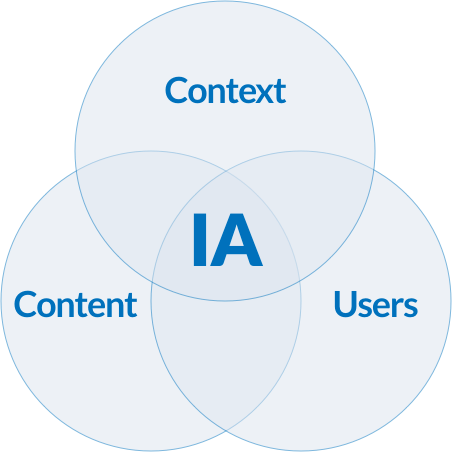
Information architecture is the critical first step to ensuring your digital government content is findable and usable by those seeking the desired information.
According to Usability.gov:
“Information architecture (IA) focuses on organizing, structuring, and labeling content in an effective and sustainable way. The goal is to help users find information and complete tasks. To do this, you need to understand how the pieces fit together to create the larger picture, how items relate to each other within the system.”
Referencing the work of IA pioneers Louis Rosenfeld and Peter Morville, Usability.gov distills IA into these components:
- Organization Schemes and Structures: How you categorize and structure information
- Labeling Systems: How you represent information
- Navigation Systems: How users browse or move through information
- Search Systems: How users look for information
Rosenfeld and Morville refer to IA as the “information ecology,” three interconnected concepts:
- Context: business goals, funding, politics, culture, technology, resources, constraints
- Content: content objectives, document and data types, volume, existing structure, governance and ownership
- Users: audience, tasks, needs, information-seeking behavior, experience
Creating your IA
According to the Nielsen Norman Group, the steps one should take when developing an IA include:
- Content inventory: Examination of a website to locate and identify existing site content
- Content audit: Evaluation of content usefulness, accuracy, tone of voice, and overall effectiveness
- Information grouping: Definition of user-centered relationships between content
- Taxonomy development: Definition of a standardized naming convention (controlled vocabulary) to apply to all site content
- Descriptive information creation: Definition of useful metadata that can be utilized to generate “Related Link” lists or other navigation components that aid discovery
Tools
Tools used to develop IA include:
ProudCity and information architecture
ProudCity helps address government-specific information architecture best practices with:
- Default, government-specific pages (i.e., ‘Residents,’ ‘Businesses,’ ‘Visitors,’ departments, news, contact)
- Navigation and menu creation/labeling (default government-specific menus/labels)
- News posts categorization (default government-specific categories)
- Answers-integrated, type-ahead site search
- Auto-generated sitemap (e.g., example.proudcity.com/sitemap)
Resources
- Information Architecture Basics (usability.gov)
- Information architecture (Wikipedia)
- Information Architecture. The Most Important Part of Design You’re Probably Overlooking. (Jacob Ruiz)
- The Difference Between Information Architecture (IA) and Navigation (Nielsen Norman Group)
- Information Architecture: For the Web and Beyond (Louis Rosenfeld, Peter Morville)
- Information Architecture Institute
ProudCity is a digital government platform that makes it easy and cost-effective to launch and manage all aspects of digital government services, including websites, meetings, online forms and payments.
Subscribe to our newsletter or connect with us on Twitter, LinkedIn and elsewhere.